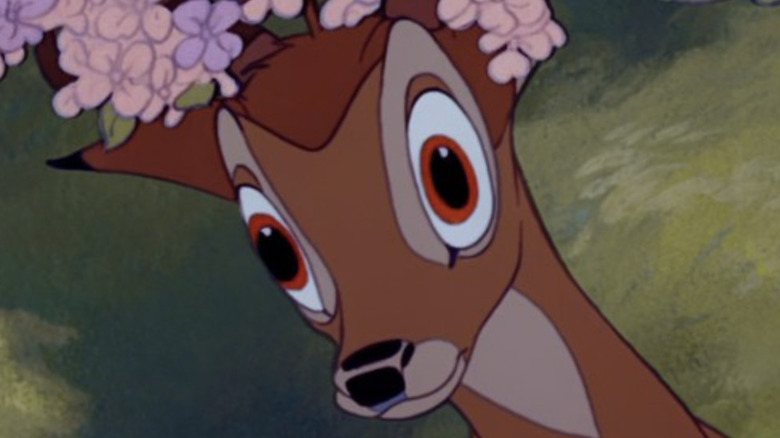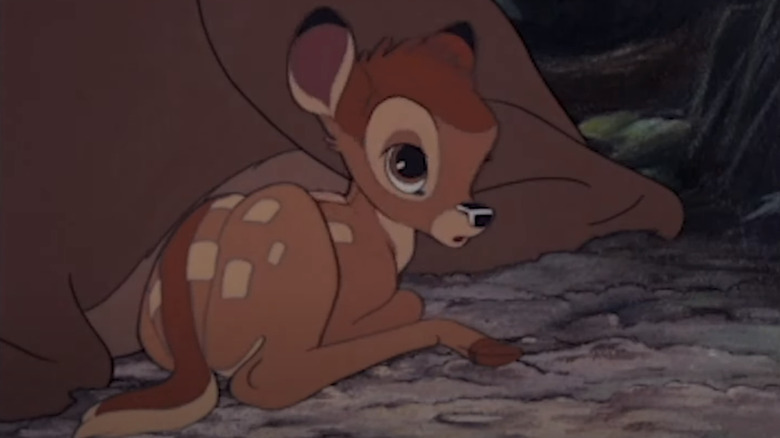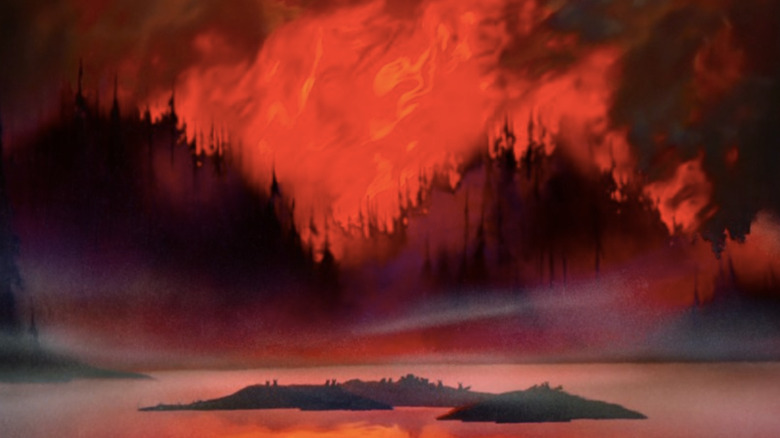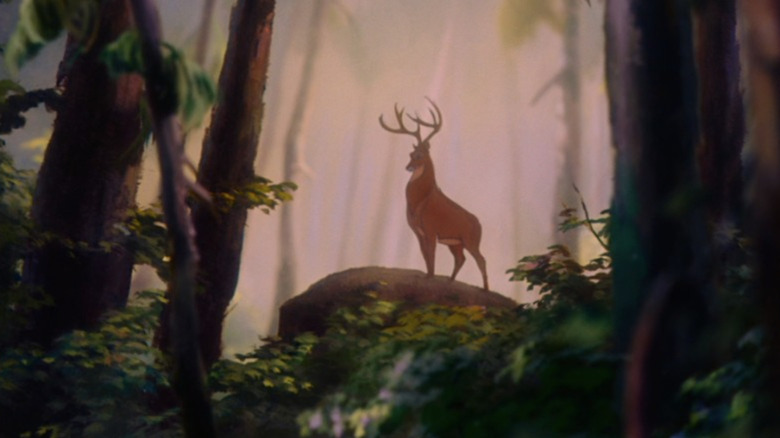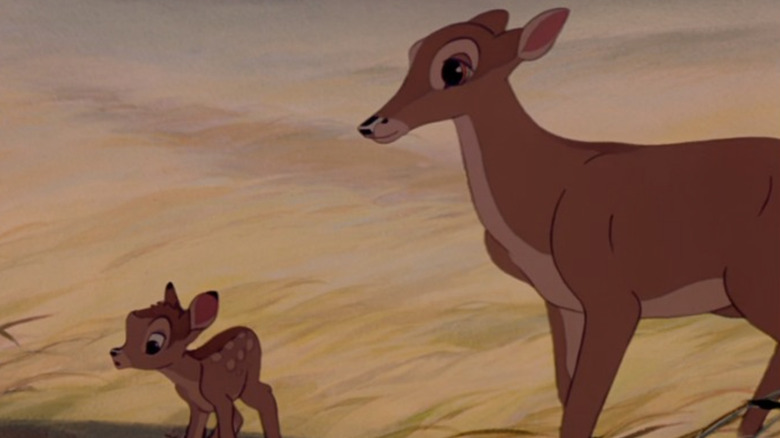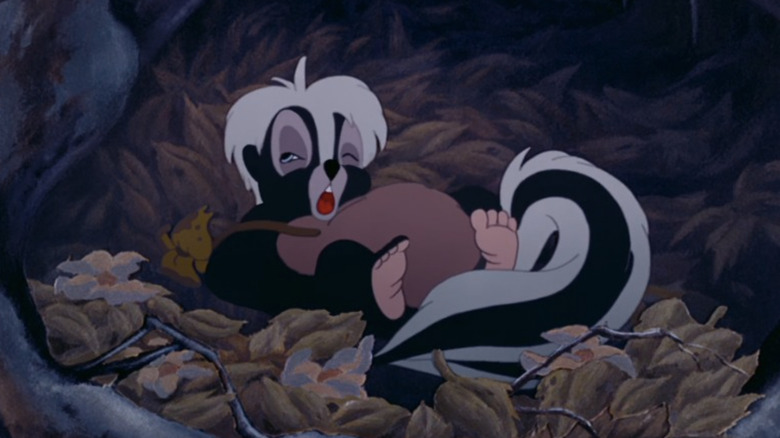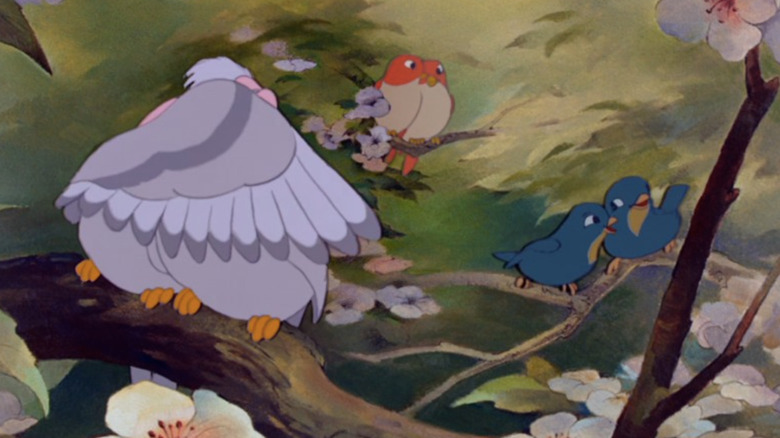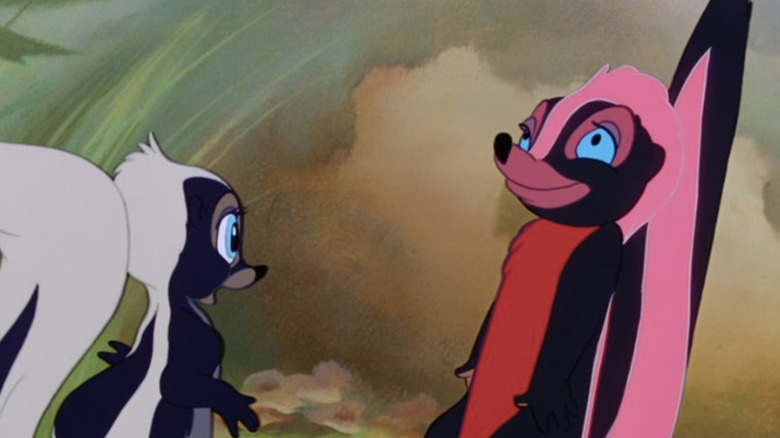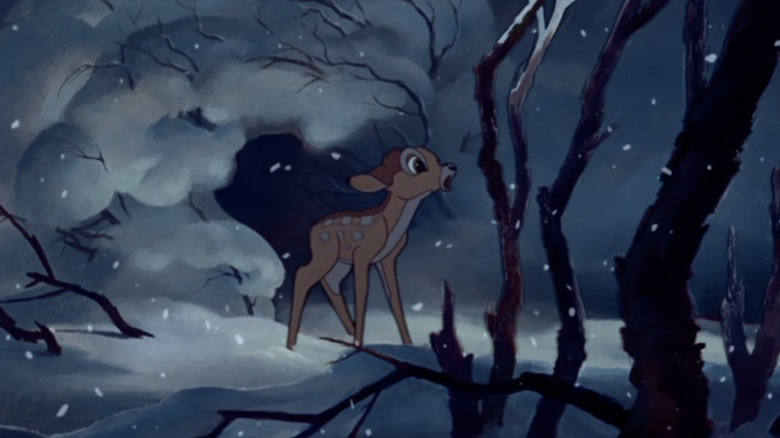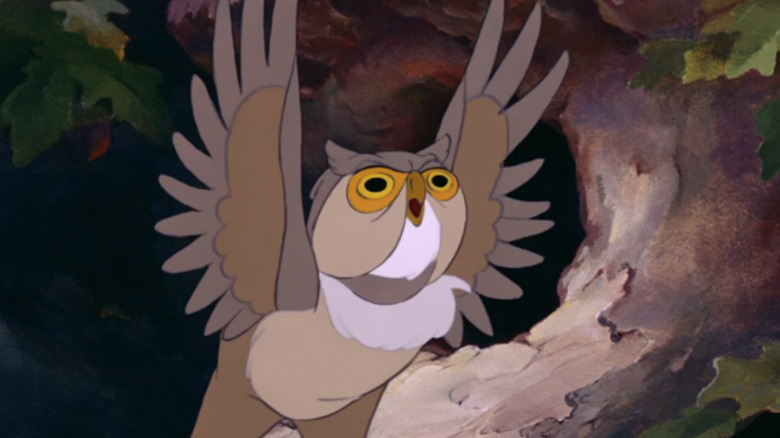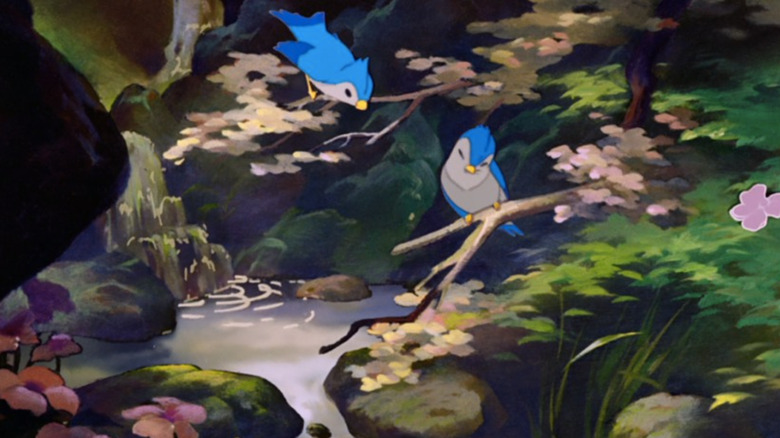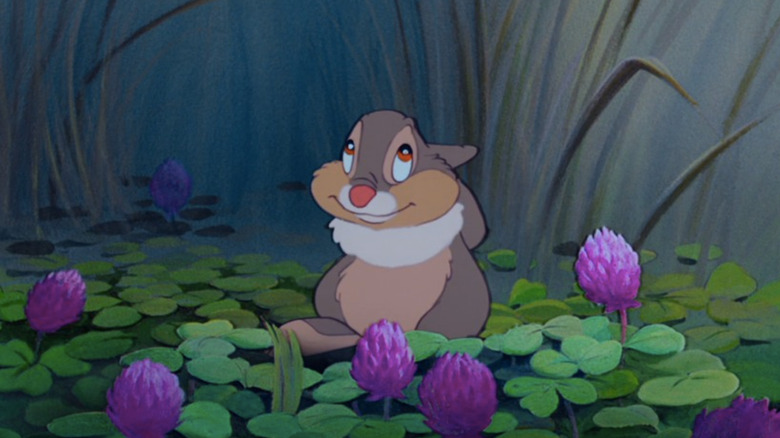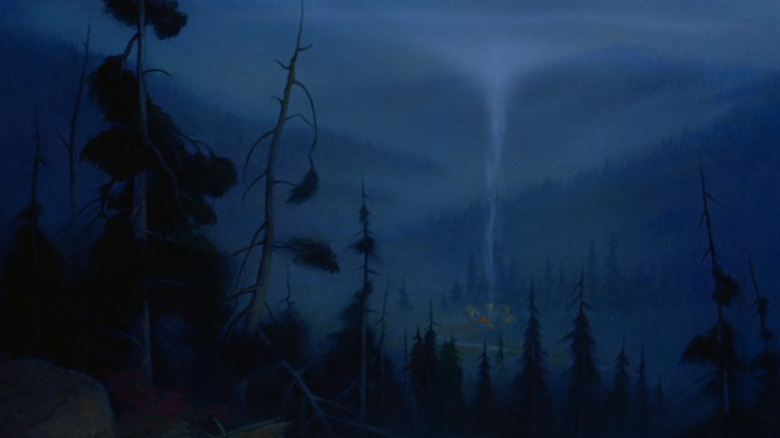Things Only Adults Notice In Bambi
The reputation of Disney's "Bambi" precedes it everywhere. If the casual moviegoer knows nothing else about the film, at the very least they're probably aware of the heart-wrenching scene in which a hunter shoots Bambi's mother — a moment that remains a benchmark for emotional sequences in family films.
Released in 1942 from Walt Disney Animation Studios, "Bambi" was the last entry in what historians recall fondly as Disney's "Golden Age." This era began with the very first full-length animated Disney movie, 1937's "Snow White and the Seven Dwarfs," and continued onward with 1940's "Pinocchio" and "Fantasia" and 1941's "Dumbo" before at last arriving at "Bambi." After that, the studio's efforts shifted significantly with the onset of World War II and stayed rocky for the remainder of the decade. But with "Bambi," there remained a strong commitment to the pioneering art form of pioneering animation.
With a studio as prolific as Disney at the top of its game, there are a few layers to the storytelling within "Bambi" that might go overlooked by younger viewers. Additionally, with the movie now being nearly a century old, some of its content has aged in a way that's only noticeable to older audience members. Here are a few things that only adults will notice in "Bambi."
There's only one woman credited in Bambi
Having debuted in 1942, the credits for "Bambi" follow the custom of the time by rolling at the beginning of the movie rather than the end. Viewers paying careful observation to the filmmakers' names may notice there's only one woman credited in an otherwise all-male crew. Retta Scott is listed as an animator on "Bambi," and adult viewers who notice this attribution and research Scott's name will find that her credit in the film is a first in Disney history. In a field dominated at the time by men, Scott was the first female animator at Walt Disney Animation Studios.
Most women at Disney during this period worked in the Ink and Paint department, tracing and coloring in between the lines drawn by the male animators and going completely unacknowledged in the credits themselves. Scott broke tradition, and in doing so made history. She continued to work at Disney throughout the 1940s before becoming an illustrator of children's books. Disney inducted Scott posthumously in 2000 as a Disney Legend, one of the company's highest honors.
Bambi's art holds up beautifully
Kids often have no frame of reference for when a movie was created. They simply enjoy the finished product for what it is, regardless of whether it debuted decades ago or last year. Adults with any basic knowledge of 1942's "Bambi" might begin watching it with preconceived expectations about its quality simply because of its age. Even if an adult viewer doesn't know the exact year "Bambi" debuted, they are likely aware of it being an older film that was released at least a few generations ago. As such, it would be easy to assume that the conventional quality of the movie would be inferior to the animation of today, purely because of the assumed advances made within the elapsed 80 years.
While modern animation certainly dazzles in its own ways, "Bambi" holds up surprisingly well from a visual standpoint, and audience members can still admire the truly breathtaking cinematography of the film. The painted backgrounds are stunning, each one a work of art, and the special effects emulating the fire are amazingly impressive when considering computer animation was still a whopping four decades away. Beyond this, the character animation is superb. After all, who can forget Bambi taking his first steps or Thumper teaching him how to glide on the ice? Despite the limitations in technology that the Disney crew might have had to work with in comparison to today's more advanced tools, they created something that truly stands the test of time.
Who's that random deer?
When Bambi's mother gives birth to her son, a majestic male deer is glimpsed standing in the distance, his antlers reaching the sky as he regally observes the welcome party but never comes near it himself. Adults may be able to put two and two together and correctly assume that this unnamed, mysterious figure is Bambi's father. Younger viewers might not make the discovery until the story points it out more clearly later on. If anything, kids might incorrectly assume that the dear is some sort of menacing character from the way he's brooding away from everyone else.
We later learn this deer is the Great Prince of the Forest. Bambi is aware of the Great Prince, but doesn't know he's his father until later on. The Great Prince remains distanced from his son until Bambi's mother dies in the Disney movie, at which point it's made clear to everyone that the Great Prince is actually his dad. Older viewers might also dig a little deeper into the dynamics of this relationship. While the duty of protecting the forest is no small task, is it necessary for the Great Prince to be completely absent from his own son's life? Since the other animals call Bambi a prince, they clearly know who his father is, so it's not like it's a scandalous secret. It seems odd that everyone should know this information except for Bambi himself.
There's a huge age gap between Bambi's parents
Before Bambi learns that the Great Prince of the Forest is his father, his mom explains to him the Great Prince's role in leading the community. "Everyone respects him," she says. "He's very brave and very wise." In describing the Great Prince to Bambi, his mother talks in a sultry voice that reveals hints of her love for him. Of course, Bambi is oblivious to this layer of the conversation and simply takes her words at face value.
Bambi's mom also notes of the Great Prince that, "Of all the deer in the forest, not one has lived half as long." Hold up. If that statement is really true, and it includes Bambi's mother herself in the statistic, that's quite a revelation. It means there's a significant age difference between Bambi's parents, with his mother being half the age of his father, at the oldest. She clearly cares for him, but he's also quite distant, leading to a number of questions about the whole situation.
Skunks don't hibernate
Each new season brings a different set of discoveries and joys for young Bambi as he experiences the cycle of nature for the very first time. Upon his first snowfall, he's eager to go play with his friend Thumper, a rabbit. He also begins to invite his skunk friend, Flower, to join in the fun, but he finds Flower fast asleep.
Groggily waking up, Flower asks, "Is it spring yet?" Thumper jokingly asks if Flower is hibernating, and the skunk surprises him by saying yes. "All us Flowers sleep in the winter," he says before promptly going back to sleep.
Adults with an interest in animals might be able to call Flower's bluff. While yes, most flowers tend to "sleep" (or rather, die) in the winter, the same isn't true of skunks. The animals typically seek refuge during cold weather, but they do not, in fact, hibernate. Still, at least the scene holds some educational value for kids in the audience who might not have heard of hibernation before. A new vocabulary word to be learned!
The birds are up to some risqué business
As "Bambi" transitions to spring, love is in the air across the forest. The camera shows a large group of birds, all coupled into pairs, enjoying each other's company. Some chase one another. Some look longingly into their partners' eyes. One bird couple even shields the visibility of their actions by forming a veil with their feathers and hiding behind it. To younger kids, all these birds are simply in love and having a grand old time. For older viewers, it's clear that in addition to the birds experiencing love as a feeling, there's clearly some actual love-making happening here, too.
Clearly, this is meant as a wink-and-nod moment to the adults in the audience, as the more mature implications of all these different couples getting together during the season of love will easily go over the heads of anyone who doesn't understand the subtext.
Twitterpated is definitely a nickname for something else
By spring, Bambi, Thumper, and Flower have seemingly hit puberty and are growing into their adult selves. Friend Owl warns them to be careful, or they might get "twitterpated" as so many other animals do in the springtime when they become infatuated with an animal they're attracted to.
If only going by Friend Owl's own definition, being "twitterpated" is strictly a physical fixation and has nothing to do with anyone's actual relational compatibility. He explains to them, "all of a sudden, you run smack into a pretty face. You begin to get weak in the knees. Your head's in a whirl. Then you feel light as a feather and before you know it, you're walking on air." So basically, "twitterpated" is when an animal gets, well, excited.
Though they insist it won't happen to them, Flower, Thumper, and Bambi all soon become twitterpated themselves as they encounter a female skunk, rabbit, and deer, respectively. As they do, the visual gags employed by the animators seem to allude to rather adult content for an otherwise tame movie, especially for Flower and Thumper. Flower's body turns red, becomes stiff, and falls over when he meets his female counterpart, while Thumper's ears point upward and his foot thumps rapidly. It brings to mind a similar gag animated decades later in Pixar's "Toy Story 2" when Buzz Lightyear's wings pop out upon seeing Jessie performing an impressive stunt.
Wait, is this just The Lion King?
A young animal is born into royalty, their father being the ruler of an animal kingdom. After the child's parent dies, the movie skips ahead to the protagonist's adulthood, when he must confront the reality of fulfilling his destiny. Does this accurately describe "Bambi"? Yes. Does it also accurately describe "The Lion King"? Also yes.
There may come a point while watching "Bambi" that older viewers gasp and realize Pride Rock totally takes a hint (or two, or three) from the Great Prince of the Forest. The stories and themes of the two Disney films are strikingly similar, though that's by design. When initially pitching "The Lion King" in the 1990s — according to the movie's home video bonus material — filmmakers referred to it as "Bambi in Africa" to help animators wrap their minds around what to aim for (via Forbes). It's not plagiarism when you're copying something from your own studio, it seems.
Some kids may identify the similarities if they've seen both films, and they may even attribute the duplicate narrative in the reverse order. "The Lion King" is no doubt a more popular film to modern audiences, and it's likely that a child might be familiar with "The Lion King" before watching "Bambi," not the other way around. However, adults who know that "Bambi" came first — over 50 years before "The Lion King," in fact — will have the record straight of who actually copied who.
Friend Owl kind of has a point
Friend Owl can't catch a break. Though he's wise and knowledgeable about the ins and outs of the forest and is happy to impart guidance to fellow members of his community, there's only so much he can take. Having a somewhat cynical outlook on life compared to the cheery optimism of the other critters, Friend Owl constantly shushes animals who are too loud for his taste and routinely seeks peace and quiet. He also frowns upon the idea of getting "twitterpated," something that the rest of the forest seems to delight in by comparison.
This worldview might be seen as undesirable to kids. If Bambi is the child protagonist metaphorically figuring out middle school, Friend Owl is, more or less, the cranky teacher who hates kids but sticks to the profession regardless. As his name implies, Friend Owl is a friend to the creatures of the forest, but perhaps a bit begrudgingly so. The character is stereotypically unappealing to kids, but adults watching the movie might be able to empathize a lot more with Friend Owl's quest for solitude. Can't a guy just get a quick second to recharge?
Let's Sing A Gay Little Spring Song
As the bitter cold of winter transitions into the sunshine and warmth of spring, an offscreen chorus performs a tune called "Let's Sing A Gay Little Spring Song" while the animals of the forest celebrate the turn of the weather. The phrasing as stated in the title is repeated several times as the main thread of the song: "Let's sing a gay little spring song. This is the season to sing. So I'd like to suggest that we all do our best and warble a song about spring."
The phrasing might confuse kids who've never lived in a time when the word "gay" was commonly used as a synonym for "happy" or "gleeful," rather than its much more common modern meaning of same-sex attraction. Adults, on the other hand, are likely aware of the word's former dual meaning.
According to queer tech platform Hornet, the use of the word "gay" as a synonym for homosexuality didn't begin until the mid-20th century, and it didn't become commonplace until even later. As time has gone on, usage of the word "gay" has increasingly referred to its meaning as a sexual orientation, which is now the much more dominant (and nearly the only) application of the word in the English language. Seeing as "Bambi" debuted in 1942, "gay" would have meant "happy" to its audience and nothing else.
Wow, that expression has been around a long time
Thumper's mother is quick to remind him of their family's values when he starts acting out of line. "What did your father tell you?" she warningly inquires. "If you can't say something nice," Thumper recites back to her, "don't say nothing at all." This is timeless wisdom, it seems, as some variation of this phrase is still well circulated today and has undoubtedly been instructed to many children in the audience watching "Bambi."
Adults might hear Thumper say the phrase and come to a realization about the longevity of modern language. Hearing the saying spoken in such an old film prompts a moment of reflection on how long the phrase has been in use. It might also lead to viewers wondering what other commonly used phrases of the 21st century are older than we might realize. To kids, though, Thumper's sentence is merely parental advice and not an existential mountaintop.
Are we the bad guys?
While there's no singular villain in "Bambi," the offscreen idea of "man" is a constant threat to the forest. Humans cut down trees, and therefore destroy habitats. A hunter shoots Bambi's mother. A manmade fire gets out of hand and burns much of the forest. With the story told from the point of view of Bambi and his fellow animals, the antagonist figure in the narrative is the imposed force of humanity upon nature.
While younger viewers may simply view the unfortunate circumstances as the scheme of an unseen bad guy, adults might have a more serious realization of their own contributions to similar situations that the film presents as negative. Even if the viewer has never set a forest ablaze, they might at least realize the very home they're watching the film in was likely at one time an untouched forest. Oops ... sorry, Bambi. The movie will have served its purpose if it leads to a sense of commitment to eco-responsibility and the ways we can all do our part to be respectful of nature.
